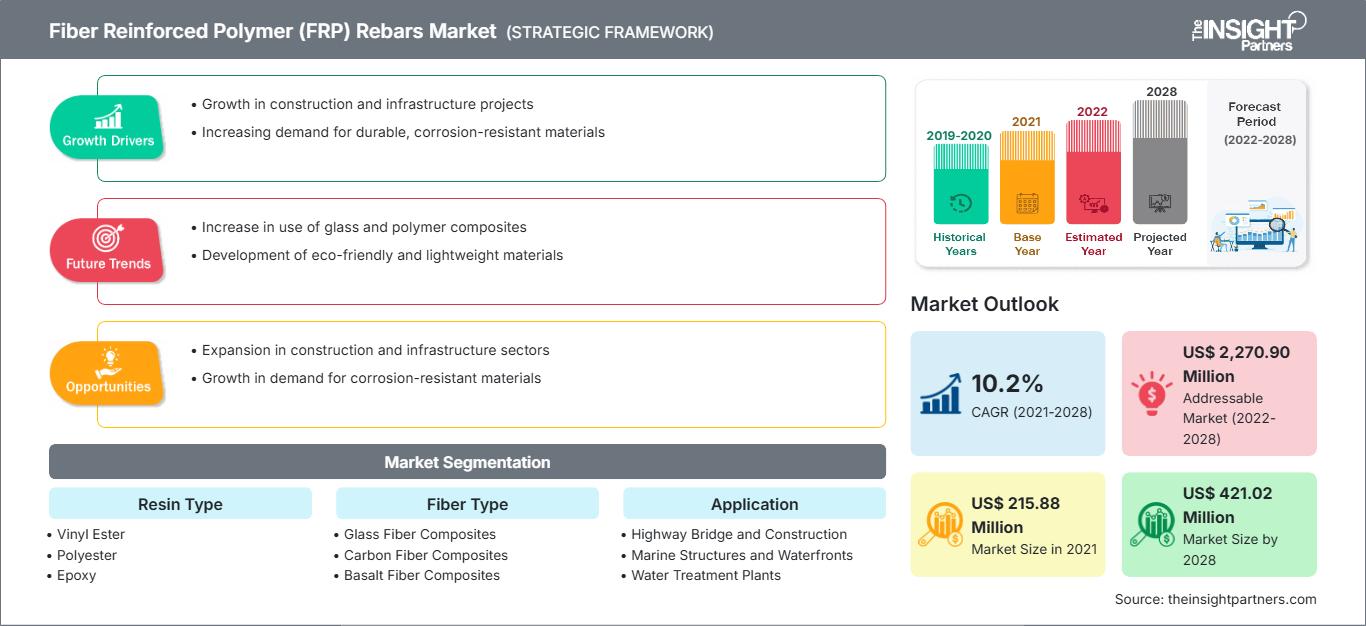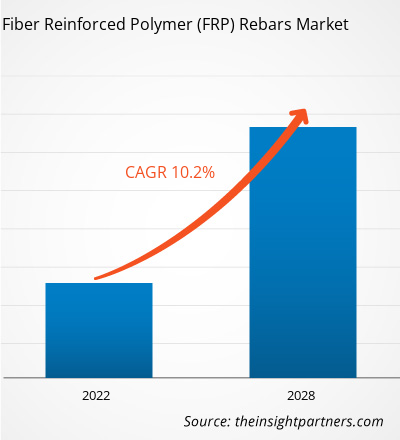Der Markt für Bewehrungsstäbe aus faserverstärktem Kunststoff (FRP) soll von 215,88 Millionen US-Dollar im Jahr 2021 auf 421,02 Millionen US-Dollar im Jahr 2028 wachsen; von 2022 bis 2028 wird mit einer durchschnittlichen jährlichen Wachstumsrate von 10,2 % gerechnet.
Da Beton druckfest, aber zugschwach ist, wird er typischerweise verstärkt, um ein zug- und druckfestes Baumaterial zu schaffen. Diese Bewehrung besteht aufgrund seiner geringen Kosten, hohen Festigkeit und Elastizität üblicherweise aus Stahl. Stahlkorrosion könnte Regierungen und Vermögenseigentümer jedoch Milliarden von Dollar an Wartungskosten kosten, um veraltete Infrastruktur zu ersetzen oder zu reparieren. Es gibt nur wenige Alternativen für Betonbewehrungsmaterialien, die Korrosion vorbeugen können. Einige Hersteller bieten beispielsweise Bewehrungsstäbe aus rostfreiem Stahl an; Bewehrungsstäbe aus faserverstärktem Kunststoff können jedoch als korrosionsbeständige Alternative zu herkömmlichen Stahlbewehrungsstäben für die Betonbewehrung dienen. Diese FRP-Bewehrungsstäbe werden aus einer Kombination von Polymermatrix mit Glas-, Kohlenstoff- oder Basaltfasern hergestellt. Diese Materialien rosten nicht, sind deutlich leichter als Stahl, leiten keine Wärme und sind fast viermal zugfest. Dank ihrer Korrosionsbeständigkeit sind faserverstärkte Kunststoffe die beste Alternative für verschiedene Bauanwendungen wie Stützmauern, Pfeiler, Anlegestellen, Kais, Senkkästen, Decks, Schotten, Pfähle, Kanäle, Offshore-Plattformen, Schwimmbäder und Aquarien.
In elektromagnetisch sensiblen Anwendungen leiten die nichtleitenden Eigenschaften von Glas und Polymer der FRP-Bewehrungsstäbe zudem keinen Strom, ziehen keine Blitzeinschläge an und stören nicht den Betrieb benachbarter elektrischer Geräte. Das macht faserverstärkte Kunststoffe zu einer sichereren Alternative zu Stahl in Aluminium- und Kupferhütten, Flughafentürmen, Kernkraftwerken, speziellen Militärstrukturen, Strom- und Telefonmasten, Schächten mit elektrischen oder telefonischen Geräten sowie Krankenhäusern mit Magnetresonanztomographie (MRT).
Passen Sie diesen Bericht Ihren Anforderungen an
Sie erhalten kostenlos Anpassungen an jedem Bericht, einschließlich Teilen dieses Berichts oder einer Analyse auf Länderebene, eines Excel-Datenpakets sowie tolle Angebote und Rabatte für Start-ups und Universitäten.
Markt für Bewehrungsstäbe aus faserverstärktem Kunststoff (FRP): Strategische Einblicke

- Holen Sie sich die wichtigsten Markttrends aus diesem Bericht.Dieses KOSTENLOSE Beispiel umfasst Datenanalysen, die von Markttrends bis hin zu Schätzungen und Prognosen reichen.
Sie erhalten kostenlos Anpassungen an jedem Bericht, einschließlich Teilen dieses Berichts oder einer Analyse auf Länderebene, eines Excel-Datenpakets sowie tolle Angebote und Rabatte für Start-ups und Universitäten.
Markt für Bewehrungsstäbe aus faserverstärktem Kunststoff (FRP): Strategische Einblicke

- Holen Sie sich die wichtigsten Markttrends aus diesem Bericht.Dieses KOSTENLOSE Beispiel umfasst Datenanalysen, die von Markttrends bis hin zu Schätzungen und Prognosen reichen.
Markteinblicke
Wachsende Bautätigkeit fördert Marktwachstum für faserverstärkte Polymer-Bewehrungsstäbe (FRP)
Die Baubranche leistet einen wichtigen Beitrag zur weltweiten Wirtschaftsentwicklung. Sie floriert rasant aufgrund der zunehmenden staatlichen Unterstützung für den weltweiten Infrastrukturausbau. Indien beispielsweise plant, von 2019 bis 2023 über die National Infrastructure Pipeline 1,4 Billionen US-Dollar für Infrastruktur auszugeben. In diese Pipeline hat die Regierung Infrastrukturen wie Strom, Brücken, Dämme, Straßen und die Entwicklung städtischer Infrastruktur aufgenommen. Aufgrund ihrer vorteilhaften Materialeigenschaften wie hohe Festigkeit, Frost- und Tausalztoleranz sowie kurze Installationszeiten bei minimaler Verkehrsbehinderung haben sich faserverstärkte Polymere zu wertvollen Ersatzbaustoffen für Brückenkonstruktionen entwickelt. Solche Initiativen der Regierungen verschiedener Länder dürften das Wachstum des Marktes für faserverstärkten Polymerbewehrungsstahl (FRP) ankurbeln.
Einblicke in Harztypen
Basierend auf dem Harztyp ist der globale Markt für faserverstärkten Polymerbewehrungsstahl (FRP) in Vinylester, Polyester, Epoxid und andere unterteilt. Im Jahr 2021 hatte das Vinylestersegment den größten Marktanteil. Vinylesterharze haben eine hohe Festigkeit, eine hohe Beständigkeit gegen Korrosion, Kraftstoffe, Chemikalien oder Dämpfe und bieten mechanische Belastbarkeit. Sie sind sehr langlebig, hitzebeständig und haben eine hohe Zugdehnungsfestigkeit. Dieses Harz kann mit Kurzglasfasern oder Kohlefasern imprägniert werden, um FRP-Bewehrungsstahl herzustellen. Die Mehrheit der Hersteller von faserverstärkten Polymerbewehrungsstahl verwendet Vinylesterharz. Die Kosteneffizienz von Vinylester hat das Wachstum des Segments gefördert.
Owens Corning; KODIAC Fiberglass Rebar; MARSHALL COMPOSITE TECHNOLOGIES, LLC; TUF-BAR; Armastek USA; Pultron Composites; FiRep Inc.;
PULTRALL, Inc.; Schock Bauteile GmbH; und Dextra Group gehören zu den wichtigsten Akteuren auf dem globalen Markt für Bewehrungsstäbe aus glasfaserverstärktem Kunststoff (GFK). Die führenden Unternehmen setzen auf Strategien wie Fusionen, Übernahmen und Produkteinführungen, um ihre geografische Präsenz und ihren Kundenstamm zu erweitern. So ist Pultron Composites beispielsweise eine Partnerschaft mit Saudi Aramco, dem führenden Ölkonzern Saudi-Arabiens, eingegangen, um seine Produktionsanlagen für Bewehrungsstäbe aus glasfaserverstärktem Kunststoff (GFK) im Land zu erweitern.
Bewehrungsstäbe aus glasfaserverstärktem Kunststoff (GFK)Regionale Einblicke in den Markt für faserverstärkte Polymerbewehrungsstäbe (FRP)
Regionale Einblicke in den Markt für faserverstärkte Polymerbewehrungsstäbe (FRP)
Die Analysten von The Insight Partners haben die regionalen Trends und Faktoren, die den Markt für faserverstärkte Kunststoffbewehrungen (FRP) im Prognosezeitraum beeinflussen, ausführlich erläutert. In diesem Abschnitt werden auch die Marktsegmente und die geografische Lage für faserverstärkte Kunststoffbewehrungen (FRP) in Nordamerika, Europa, im asiatisch-pazifischen Raum, im Nahen Osten und Afrika sowie in Süd- und Mittelamerika erörtert.
Umfang des Marktberichts zu faserverstärkten Kunststoffbewehrungsstäben (FRP)
| Berichtsattribut | Einzelheiten |
|---|---|
| Marktgröße in 2021 | US$ 215.88 Million |
| Marktgröße nach 2028 | US$ 421.02 Million |
| Globale CAGR (2021 - 2028) | 10.2% |
| Historische Daten | 2019-2020 |
| Prognosezeitraum | 2022-2028 |
| Abgedeckte Segmente |
By Harztyp
|
| Abgedeckte Regionen und Länder | Nordamerika
|
| Marktführer und wichtige Unternehmensprofile |
|
Dichte der Marktteilnehmer für faserverstärkte Polymer-Bewehrungsstäbe (FRP): Verständnis ihrer Auswirkungen auf die Geschäftsdynamik
Der Markt für faserverstärkte Kunststoff-Bewehrungsstäbe (FRP) wächst rasant. Die steigende Nachfrage der Endverbraucher ist auf Faktoren wie veränderte Verbraucherpräferenzen, technologische Fortschritte und ein stärkeres Bewusstsein für die Produktvorteile zurückzuführen. Mit der steigenden Nachfrage erweitern Unternehmen ihr Angebot, entwickeln Innovationen, um den Bedürfnissen der Verbraucher gerecht zu werden, und nutzen neue Trends, was das Marktwachstum weiter ankurbelt.

- Holen Sie sich die Markt für Bewehrungsstäbe aus faserverstärktem Kunststoff (FRP) Übersicht der wichtigsten Akteure
Bericht-Spotlights
- Progressive Trends in der Branche für faserverstärkten Polymer (FRP)-Bewehrungsstahl, um Akteuren bei der Entwicklung effektiver langfristiger Strategien zu helfen
- Geschäftswachstumsstrategien von Unternehmen zur Sicherung des Wachstums in entwickelten und sich entwickelnden Märkten
- Quantitative Analyse des globalen Marktes für faserverstärkten Polymer (FRP)-Bewehrungsstahl von 2022 bis 2028
- Schätzung der Nachfrage nach faserverstärkten Polymer (FRP)-Bewehrungsstahl
- Porters Analyse zur Veranschaulichung der Wirksamkeit von in der Branche tätigen Käufern und Lieferanten bei der Vorhersage des Marktwachstums
- Jüngste Entwicklungen zum Verständnis des Wettbewerbsmarktszenarios und der Nachfrage nach faserverstärkten Polymer (FRP)-Bewehrungsstahl
- Markttrends und -aussichten sowie Faktoren, die das Wachstum des globalen Marktes für faserverstärkten Polymer (FRP)-Bewehrungsstahl vorantreiben und hemmen
- Verständnis der Strategien, die das kommerzielle Interesse im Hinblick auf den globalen Markt für faserverstärkten Polymer (FRP) untermauern Marktwachstum für Bewehrungsstäbe, Unterstützung des Entscheidungsprozesses
- Globale Marktgröße für Bewehrungsstäbe aus faserverstärkten Polymeren (FRP) an verschiedenen Marktknotenpunkten
- Detaillierte Übersicht und Segmentierung des globalen Marktes für Bewehrungsstäbe aus faserverstärkten Polymeren (FRP) und seiner Branchendynamik
- Globale Marktgröße für Bewehrungsstäbe aus faserverstärkten Polymeren (FRP) in verschiedenen Regionen mit vielversprechenden Wachstumschancen
Die „Marktanalyse für Bewehrungsstäbe aus faserverstärkten Polymeren (FRP) bis 2028“ ist eine spezialisierte und gründliche Studie der Chemie- und Werkstoffindustrie, die sich auf die Trendanalyse des Marktes für Bewehrungsstäbe aus faserverstärkten Polymeren (FRP) konzentriert. Der Bericht soll einen Überblick über den Markt mit detaillierter Segmentierung bieten. Der Markt für Bewehrungsstäbe aus faserverstärkten Polymeren (FRP) ist nach Harztyp, Fasertyp, Anwendung und Geografie segmentiert. Basierend auf dem Harztyp ist der Markt in Vinylester, Polyester, Epoxid und andere segmentiert. Basierend auf dem Fasertyp ist der Markt in Glasfaser-, Kohlefaser- und Basaltfaserverbundwerkstoffe segmentiert. Basierend auf der Anwendung ist der Markt in Autobahnbrücken und -bau, Meeresbauwerke und Uferpromenaden, Wasseraufbereitungsanlagen und andere segmentiert. Geografisch ist der Markt in fünf Hauptregionen unterteilt: Nordamerika, Europa, Asien-Pazifik, Naher Osten und Afrika sowie Süd- und Mittelamerika. Im Jahr 2021 dominierte Nordamerika den Markt für faserverstärkten Kunststoff (FRP)-Bewehrungsstahl. Es wird jedoch erwartet, dass der Asien-Pazifik-Raum im Prognosezeitraum die höchste durchschnittliche jährliche Wachstumsrate (CAGR) verzeichnet.
- Historische Analyse (2 Jahre), Basisjahr, Prognose (7 Jahre) mit CAGR
- PEST- und SWOT-Analyse
- Marktgröße Wert/Volumen – Global, Regional, Land
- Branchen- und Wettbewerbslandschaft
- Excel-Datensatz
Aktuelle Berichte
Erfahrungsberichte
Grund zum Kauf
- Fundierte Entscheidungsfindung
- Marktdynamik verstehen
- Wettbewerbsanalyse
- Kundeneinblicke
- Marktprognosen
- Risikominimierung
- Strategische Planung
- Investitionsbegründung
- Identifizierung neuer Märkte
- Verbesserung von Marketingstrategien
- Steigerung der Betriebseffizienz
- Anpassung an regulatorische Trends




















 Kostenlose Probe anfordern für - Markt für Bewehrungsstäbe aus faserverstärktem Kunststoff (FRP)
Kostenlose Probe anfordern für - Markt für Bewehrungsstäbe aus faserverstärktem Kunststoff (FRP)